《电路》课程教学大纲 Electric Circuit B
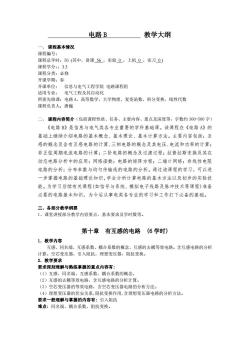
电路B 教学大纲 课程基本情况 课程编号: 课程总学时:6(其中,讲课56,实验0,上机0,实习0) 课程学分:3.5 课程分类:必修 开课学期:春 开课单位:信息与电气工程学院电路课程组 适用专业:电气工程及其自动化 所需先修课:电路A,高等数学,大学物理,复变函数,积分变换,线性代数 课程负责人:唐巍 二、 课程内容简介(包括课程性质、任务、主要内容、重点及深度等,字数约300-500字》 《电路B》是信息与电气类各专业重要的学科基础课。该课程在《电路A》的 基础上继续介绍电路的基本概念、基本理论、基本计算方法。主要内容包括:互 感的概念及含有互感电路的计算、三相电路的概念及其电压、电流和功率的计算; 非正弦周期电流电路的计算;二阶电路的概念及过渡过程;拉普拉斯变换及其在 动态电路分析中的应用;网络函数:电路的矩阵方程;二端口网络;非线性电阻 电路的分析;分布参数与均匀传输线的电路的分析。通过该课程的学习,可以进 一步掌握电路的基础理论知识,学会分析计算电路的基本方法以及初步的实验技 能。为学习后续有关课程(如信号与系统、模拟电子线路及脉冲技术等课程)准备 必要的电路基本知识,为今后从事电类各专业的学习和工作打下必备的基础。 三、各部分教学纲要 1、课堂讲授部分教学内容要点、基本要求及学时数等。 第十章有互感的电路(6学时) 1.教学内容 互感、同名端、互感系数、耦合系数的概念,互感的去耦等效电路。含互感电路的分析 计算。空芯变压器,引入阻抗,理想变压器,阻抗变换 2.散学要求 要求深刻理解与熟练掌握的里点内容有: (1)互感、同名端、互感系数、耦合系数的概念。 (2)互感的去摄等效电路,含互城电路的分析计算 的 (4)理想变压器的 要求一般理解与掌握的内容有:引入阻抗 难点:同名端、耦合系数、阻抗变换
电路 B 教学大纲 一、 课程基本情况 课程编号: 课程总学时:56 (其中,讲课 56 ,实验 0 ,上机 0 ,实习 0 ) 课程学分::3.5 课程分类:必修 开课学期:春 开课单位: 信息与电气工程学院 电路课程组 适用专业: 电气工程及其自动化 所需先修课:电路 A,高等数学,大学物理,复变函数,积分变换,线性代数 课程负责人:唐巍 二、 课程内容简介(包括课程性质、任务、主要内容、重点及深度等,字数约 300-500 字) 《电路 B》是信息与电气类各专业重要的学科基础课。该课程在《电路 A》的 基础上继续介绍电路的基本概念、基本理论、基本计算方法。主要内容包括:互 感的概念及含有互感电路的计算、三相电路的概念及其电压、电流和功率的计算; 非正弦周期电流电路的计算;二阶电路的概念及过渡过程;拉普拉斯变换及其在 动态电路分析中的应用;网络函数;电路的矩阵方程;二端口网络;非线性电阻 电路的分析;分布参数与均匀传输线的电路的分析。通过该课程的学习,可以进 一步掌握电路的基础理论知识,学会分析计算电路的基本方法以及初步的实验技 能。为学习后续有关课程(如信号与系统、模拟电子线路及脉冲技术等课程)准备 必要的电路基本知识,为今后从事电类各专业的学习和工作打下必备的基础。 三、各部分教学纲要 1、课堂讲授部分教学内容要点、基本要求及学时数等。 第十章 有互感的电路 (6 学时) 1.教学内容 互感、同名端、互感系数、耦合系数的概念,互感的去耦等效电路。含互感电路的分析 计算。空芯变压器,引入阻抗,理想变压器,阻抗变换。 2.教学要求 要求深刻理解与熟练掌握的重点内容有: (1)互感、同名端、互感系数、耦合系数的概念。 (2)互感的去耦等效电路,含互感电路的分析计算。 (3)空芯变压器的等效电路,含空芯变压器电路的分析方法。 (4)理想变压器的伏安关系,阻抗变换作用,含理想变压器电路的分析方法。 要求一般理解与掌握的内容有: 引入阻抗 难点: 同名端、耦合系数、阻抗变换
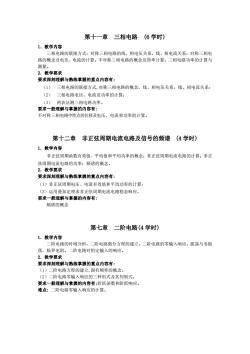
第十一章三相电路(6学时) 1.教学内容 三相电路的联接方式:对称三相电路的线、相电压关系,线、相电流关系:对称三相电 路的概念及电压、电流的计算:不对称三相电路的概念及简单计算:三相电路功率的计算与 训品。 2。教学要求 要求深刻理解与熟练掌握的重点内容有 (1)三相电路的联接方式,对称三相电路的概念,线、相电压关系,线、相电流关系: (2) 三相电路电压、电流及功率的计算: (3)两表法测三相电路功率。 要求一般理解与掌握的内容有: 不对称三相电路中性点的位移及电压、电流和功率的计算 第十二章非正弦周期电流电路及信号的频谱(4学时) 1.教学内容 非正弦周期函数有效值、平均值和平均功率的概念:非正弦周期电流电路的计算:非正 弦周期电流电路的功率:频谱的概念。 2。教学要求 要求深刻理解与熟练掌握的重点内容有: (1)非正弦周期电压、电流有效值和平均功率的计算 (2)运用叠加定理求非正弦周期电流电路稳态响应。 要求一般理解与掌握的内容有: 频谱的概念 第七章二阶电路(4学时) 1.教学内容 二阶电路的时域分析,二阶电路微分方程的建立。二阶电路的零输入响应,振荡与非振 荡,界电阻。二阶电路对恒定输入的响应。 2.教学要求 要求深刻理解与熟练掌握的重点内容有: (1)二阶电路方程的建立,周有频率的概念。 (2)二阶电路零输入响应的三种形式及其判别式 要求一般理解与掌握的内容有:阶跃函数和阶跃响应 难点:二阶电路零输入响应的计算
第十一章 三相电路 (6 学时) 1.教学内容 三相电路的联接方式;对称三相电路的线、相电压关系,线、相电流关系;对称三相电 路的概念及电压、电流的计算;不对称三相电路的概念及简单计算;三相电路功率的计算与 测量。 2.教学要求 要求深刻理解与熟练掌握的重点内容有: (1) 三相电路的联接方式,对称三相电路的概念,线、相电压关系,线、相电流关系; (2) 三相电路电压、电流及功率的计算; (3) 两表法测三相电路功率。 要求一般理解与掌握的内容有: 不对称三相电路中性点的位移及电压、电流和功率的计算。 第十二章 非正弦周期电流电路及信号的频谱 (4 学时) 1.教学内容 非正弦周期函数有效值、平均值和平均功率的概念;非正弦周期电流电路的计算;非正 弦周期电流电路的功率;频谱的概念。 2.教学要求 要求深刻理解与熟练掌握的重点内容有: (1)非正弦周期电压、电流有效值和平均功率的计算; (2)运用叠加定理求非正弦周期电流电路稳态响应。 要求一般理解与掌握的内容有: 频谱的概念 第七章 二阶电路(4 学时) 1.教学内容 二阶电路的时域分析,二阶电路微分方程的建立。二阶电路的零输入响应,振荡与非振 荡,临界电阻。二阶电路对恒定输入的响应。 2.教学要求 要求深刻理解与熟练掌握的重点内容有: (1)二阶电路方程的建立,固有频率的概念。 (2)二阶电路零输入响应的三种形式及其判别式。 要求一般理解与掌握的内容有:阶跃函数和阶跃响应。 难点: 二阶电路零输入响应的计算
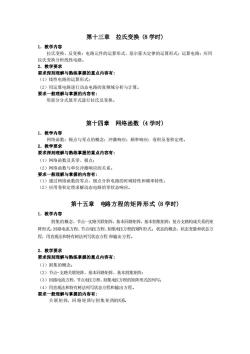
第十三章拉氏变换(8学时) 1.学内容 拉氏变换、反变换:电路元件的运算形式,基尔霍夫定律的运算形式:运算电路:应用 拉氏变换分析线性电路。 2.教学要求 要求深刻理解与熟练掌握的重点内容有 (1)线性电路的云算形式: (2)用运算电路进行动态电路的复频域分析与计算。 要求一般理解与掌握的内容有: 用部分分式展开式进行拉氏反变换。 第十四章网络函数(4学时) 1.散学内容 网络函数:极点与零点的概念:冲激响应:频率响应:卷积及卷积定理 2.教学要求 要求深刻理解与熟练掌握的重点内容有: (1)网络函数及其零、极点: (2)网络函数与单位冲激响应的关系。 要求一般理解与掌握的内容有: (1)通过网络函数的零点、极点分析电路的时域特性和频率特性: (2)应用卷积定理求解动态电路的零状态响藏。 第十五章电路方程的矩阵形式(8学时) 1.教学内容 割集的概念,节点一支路关联矩阵,基本回路矩阵,基本割集矩阵:复合支路构成关系的矩 阵形式:回路电流方程、节点电纸方程、割集电纸方程的知阵形式:状态的概念,状态变量和状态方 程,用直观法和特有树法列写状态方程和输出方程。 2。数学要求 要求深刻理解与熟练掌握的重点内容有 (1)割集的概念: (2)节点支路关联矩阵、基本回路矩阵、基本割集矩阵: (3)回路电流方程、节点电纸方程、割集电纸方程的矩阵形式的列写: (4)用直观法和特有树法列写状态方程和输出方程。 要求一般理解与掌握的内容有: 关联矩阵回路矩阵与割集矩阵的关系
第十三章 拉氏变换 (8 学时) 1.教学内容 拉氏变换、反变换;电路元件的运算形式,基尔霍夫定律的运算形式;运算电路;应用 拉氏变换分析线性电路。 2.教学要求 要求深刻理解与熟练掌握的重点内容有: (1)线性电路的运算形式; (2)用运算电路进行动态电路的复频域分析与计算。 要求一般理解与掌握的内容有: 用部分分式展开式进行拉氏反变换。 第十四章 网络函数 (4 学时) 1.教学内容 网络函数;极点与零点的概念;冲激响应;频率响应;卷积及卷积定理。 2.教学要求 要求深刻理解与熟练掌握的重点内容有: (1)网络函数及其零、极点; (2)网络函数与单位冲激响应的关系。 要求一般理解与掌握的内容有: (1)通过网络函数的零点、极点分析电路的时域特性和频率特性; (2)应用卷积定理求解动态电路的零状态响应。 第十五章 电路方程的矩阵形式 (8 学时) 1.教学内容 割集的概念,节点一支路关联矩阵,基本回路矩阵,基本割集矩阵;复合支路构成关系的矩 阵形式;回路电流方程、节点电压方程、割集电压方程的矩阵形式;状态的概念,状态变量和状态方 程,用直观法和特有树法列写状态方程 和输出方程。 2.教学要求 要求深刻理解与熟练掌握的重点内容有: (1)割集的概念; (2)节点-支路关联矩阵、基本回路矩阵、基本割集矩阵; (3)回路电流方程、节点电压方程、割集电压方程的矩阵形式的列写; (4)用直观法和特有树法列写状态方程和输出方程。 要求一般理解与掌握的内容有: 关联矩阵、回路矩阵与割集矩阵的关系
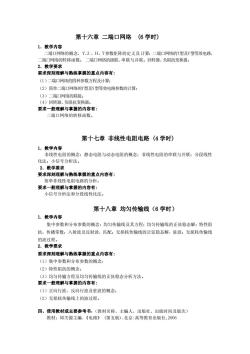
第十六章二端口网络(6学时) 1.教学内容 端口网路的概念,Y、Z、H、T参数矩阵的定义及计算:二端口网路的T型及Y型等效电路, 二端口网络的转移函数:二端口网络的级联、串联与并联:回转器、负阻抗变换器。 2.教学要求 要求深刻理解与熟练掌握的重点内容有: (1)二端口网络的四种参数方程及计算: (2)简单二端口网络的T型及Y型等效电路参数的计算: (3)二端口网络的联接: (4)回转器、负阻抗变换器。 要求一般理解与掌提的内容有: 二端口网络的转移函数 第十七章非线性电阻电路(4学时) 1.教学内 线样 电阻的概念:静态电阻与动态电阻的概念:非线性电阻的串联与并联:分段线性 化法:小信号分析法。 2.教学要求 要求深刻理解与熟练掌握的重点内容有: 简单非线性电阻电路的分析。 要求一般理解与掌握的内容有 小信号分析法和分段线性化法。 第十八章均匀传输线(6学时) 1.教学内容 集中参数和分布参数的概念:均匀传输线及其方程:均匀传输线的正弦稳态解:特性阻 抗,传播常数:入射波及反射波,匹配:无损耗传输线的正弦稳态解,驻波:无损耗传输线 的波过程。 2.教学要求 要求深刻理解与熟练掌握的重点内容有 (1)集中参数和分布参数的概念: (2)特性阻抗的概念: (3)均匀传输方程及均匀传输线的正弦稳态分析方法。 要求一般理解与掌握的内容有: (1)正向行波、反向行波及驻波的概念 (2)无损耗传输线上的波过程。 四、使用教材或主要参考书:(教材名称、主编人、出版社、出版时间及版次) 教材:邱关源主编。《电路》(第五版).北京:高等教有出版社,2006
第十六章 二端口网络 (6 学时) 1.教学内容 二端口网络的概念,Y、Z 、H、T参数矩阵的定义及 计算;二端口网络的T型及Y型等效电路, 二端口网络的转移函数; 二端口网络的级联、串联与并联;回转器、负阻抗变换器。 2.教学要求 要求深刻理解与熟练掌握的重点内容有: (1)二端口网络的四种参数方程及计算; (2)简单二端口网络的T型及Y型等效电路参数的计算; (3)二端口网络的联接; (4)回转器、负阻抗变换器。 要求一般理解与掌握的内容有: 二端口网络的转移函数。 第十七章 非线性电阻电路 (4 学时) 1.教学内容 非线性电阻的概念;静态电阻与动态电阻的概念;非线性电阻的串联与并联;分段线性 化法;小信号分析法。 2.教学要求 要求深刻理解与熟练掌握的重点内容有: 简单非线性电阻电路的分析。 要求一般理解与掌握的内容有: 小信号分析法和分段线性化法。 第十八章 均匀传输线(6 学时) 1.教学内容 集中参数和分布参数的概念;均匀传输线及其方程;均匀传输线的正弦稳态解;特性阻 抗,传播常数;入射波及反射波,匹配;无损耗传输线的正弦稳态解,驻波;无损耗传输线 的波过程。 2.教学要求 要求深刻理解与熟练掌握的重点内容有: (1)集中参数和分布参数的概念; (2)特性阻抗的概念; (3)均匀传输方程及均匀传输线的正弦稳态分析方法。 要求一般理解与掌握的内容有: (1)正向行波、反向行波及驻波的概念; (2)无损耗传输线上的波过程。 四、使用教材或主要参考书:(教材名称、主编人、出版社、出版时间及版次) 教材:邱关源主编.《电路》 (第五版).北京:高等教育出版社,2006
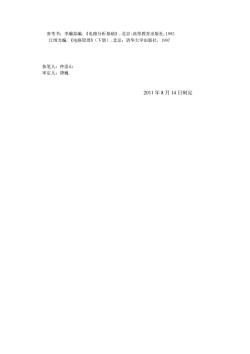
参考书:李瀚荪编.《电路分析基础》.北京:高等教有出版社,1993 江缉光编.《电路原理》(下册),北京:清华大学出版社,1997 执笔人:仲崇山 审定人:唐巍 2011年8月14日制定
参考书:李瀚荪编.《电路分析基础》.北京:高等教育出版社,1993 江缉光编.《电路原理》(下册).北京:清华大学出版社,1997 执笔人:仲崇山 审定人:唐巍 2011 年 8 月 14 日制定
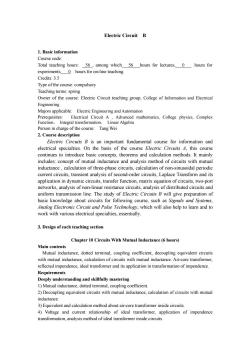
Eleetrie Circuit B 1.Basic information Course code: Total teaching hours:56,among which 56 hours for lectures.0 hours for experiments,0 hours for on-line teaching. Credits:3.5 Type of the course:compulsory T aching terms:spring Owner of the course:Electric Circuit teaching group,College of Information and Electrical Engineering Majors applicable:Electric Engineering and Automation Prerequisites: Electrical Circuit A ,Advanced mathematics,College physics,Complex Function.Integral transformation.Linear Algebra Person in charge of the course:Tang Wei 2.Course description Electric Circuits B is an important fundamental course for information and electrical specialties.On the basis of the course Electric Circuits A.this cou basi oneps,theorems and methods.It mainly ncludes:concept of mutual inductance and analysis method of circuits with mutua inductance,calculation of three-phase circuits,calculation of non-sinusoidal periodic current circuits,transient analysis of second-order circuits,Laplace Transform and its fuctionarfw-o works,analy n-lin its s of distributed circ uits nd basic knowledge about circuits for following course,such as Signals and Systems, Analog Electronic Circuit and Pulse Technology,which will also help to learn and to work with various electrical specialties,essentially. B.Design of each teaching section Chapter 10 Circuits With Mutual Inductance(6 hours) Main contents Mutual inductance,dotted terminal,coupling decoupling equivalent circuits ctan alculation of c mutual indu ctanc e transforme e.iersformer ad iticioninasformtion f mendee Requirements Deeply understanding and skillfully mastering 1)Mutual inductance,dotted terminal,coupling coefficient. 2)Decoupling quivalent circuits with mutual inductance,calculation of circuits with mutual inductance 3)Equivalent and calculation method about air-core transformer inside circuits. 4)Voltage and current relationship of ideal transformer,application of impendence transformation,analysis method of ideal transformer inside circuits
Electric Circuit B 1. Basic information Course code: Total teaching hours: 56 , among which 56 hours for lectures, 0 hours for experiments, 0 hours for on-line teaching. Credits: 3.5 Type of the course: compulsory Teaching terms: spring Owner of the course: Electric Circuit teaching group, College of Information and Electrical Engineering Majors applicable: Electric Engineering and Automation Prerequisites: Electrical Circuit A , Advanced mathematics, College physics, Complex Function, Integral transformation, Linear Algebra Person in charge of the course: Tang Wei 2. Course description Electric Circuits B is an important fundamental course for information and electrical specialties. On the basis of the course Electric Circuits A, this course continues to introduce basic concepts, theorems and calculation methods. It mainly includes: concept of mutual inductance and analysis method of circuits with mutual inductance , calculation of three-phase circuits, calculation of non-sinusoidal periodic current circuits, transient analysis of second-order circuits, Laplace Transform and its application in dynamic circuits, transfer function, matrix equation of circuits, two-port networks, analysis of non-linear resistance circuits, analysis of distributed circuits and uniform transmission line. The study of Electric Circuits B will give preparation of basic knowledge about circuits for following course, such as Signals and Systems, Analog Electronic Circuit and Pulse Technology, which will also help to learn and to work with various electrical specialties, essentially. 3. Design of each teaching section Chapter 10 Circuits With Mutual Inductance (6 hours) Main contents Mutual inductance, dotted terminal, coupling coefficient, decoupling equivalent circuits with mutual inductance, calculation of circuits with mutual inductance. Air-core transformer, reflected impendence, ideal transformer and its application in transformation of impendence. Requirements Deeply understanding and skillfully mastering 1) Mutual inductance, dotted terminal, coupling coefficient. 2) Decoupling equivalent circuits with mutual inductance, calculation of circuits with mutual inductance. 3) Equivalent and calculation method about air-core transformer inside circuits. 4) Voltage and current relationship of ideal transformer, application of impendence transformation, analysis method of ideal transformer inside circuits
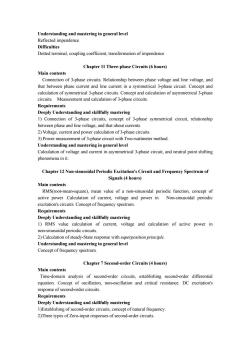
Understanding and mastering in general level Reflected impendence. Dotted terminal,coupling coefficient,transformation of impendence Chapter 11 Three-phase Circuits(6 hours) Main contents of 3-phase ciruits.Relationship between phase ine votage.and that between phase current and line current in a symmetrical 3-phase circuit.Concept and calculation of symmetrical 3-phase circuits.Concept and calculation of asymmetrical 3-phase circuits.Measurement and calculation of 3-phase circuits. Requirements Deeply Understanding and skillfully mastering )Connection of 3-phase circuits ncept of 3-phase symmetrical circuit,relationship between phase and line voltage,and that about currents. 2)Voltage,current and power calculation of 3-phase circuits. 3)Power measurement of 3-phase circuit with Two-wattmeter method. Understanding and mastering in general level Calculation of voltage and current in asymmetrical 3-phase circuit,and neutral point shifting phenomena in it Chapter 12 Non-sinusoidal Periodic Excitation's Circuit and Frequency Spectrum of Signals (4 hours) Main contents RMS(t-man-quare),mean vale of a -function.of active power .Calculation of current,voltage and power in Non-sinusoidal periodic excitation's circuits.Concept of frequency spectrum. Requirements Deeply Understanding and skillfully mastering 1)RMS value calculation of current.voltage and calculation of active power in non-sinusoidal perodic circuits 2)Calculation of steady-State response with superposition principle. Understanding and mastering in general level Concept of frequency spectrum Chapter 7Second-order Circuits(4 hours) Main contents Time-domain analysis of second-order circuits,establishing second-order differential equation.Concept of oscillation,non-oscillation and critical resistance.DC excitation's response of second-order circuits. Deeply Understanding and skillfully mastering 1)Establishing of second-order circuits,concept of natural frequency. 2)Three types of Zero-input responses of second-order circuits
Understanding and mastering in general level Reflected impendence. Difficulties Dotted terminal, coupling coefficient, transformation of impendence Chapter 11 Three-phase Circuits (6 hours) Main contents Connection of 3-phase circuits. Relationship between phase voltage and line voltage, and that between phase current and line current in a symmetrical 3-phase circuit. Concept and calculation of symmetrical 3-phase circuits. Concept and calculation of asymmetrical 3-phase circuits. Measurement and calculation of 3-phase circuits. Requirements Deeply Understanding and skillfully mastering 1) Connection of 3-phase circuits, concept of 3-phase symmetrical circuit, relationship between phase and line voltage, and that about currents. 2) Voltage, current and power calculation of 3-phase circuits. 3) Power measurement of 3-phase circuit with Two-wattmeter method. Understanding and mastering in general level Calculation of voltage and current in asymmetrical 3-phase circuit, and neutral point shifting phenomena in it. Chapter 12 Non-sinusoidal Periodic Excitation's Circuit and Frequency Spectrum of Signals (4 hours) Main contents RMS(root-mean-square), mean value of a non-sinusoidal periodic function, concept of active power .Calculation of current, voltage and power in Non-sinusoidal periodic excitation's circuits. Concept of frequency spectrum. Requirements Deeply Understanding and skillfully mastering 1) RMS value calculation of current, voltage and calculation of active power in non-sinusoidal periodic circuits. 2) Calculation of steady-State response with superposition principle. Understanding and mastering in general level Concept of frequency spectrum. Chapter 7 Second-order Circuits (4 hours) Main contents Time-domain analysis of second-order circuits, establishing second-order differential equation. Concept of oscillation, non-oscillation and critical resistance. DC excitation's response of second-order circuits. Requirements Deeply Understanding and skillfully mastering 1)Establishing of second-order circuits, concept of natural frequency. 2)Three types of Zero-input responses of second-order circuits
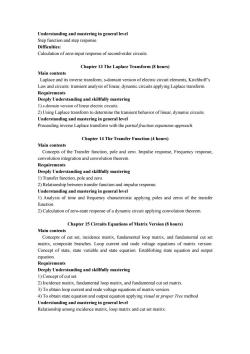
Understanding and mastering in general level ulties Calculation of zero-input response of second-order circuits. Chapter 13 The Laplace Transform(8 hours) Main contents Laplace and its inverse transfomm,s-domain version ofelectric circuitelements Kirchhoffs Law and circuits.transient analysis of linear,dynamic circuits applying Laplace transform. Requirements Deeply Understanding and skillfully mastering 1)s-domain version of linear electric circuits. 2)Using Laplace transform todetermine the transient behavior of inear,dynamic circuits Understanding and mastering in general level Proceeding inverse Laplace transform with the partial fraction expansion approach. Chapter 14 The Transfer Function(4 hours) Main contents Concepts of the Transfer function,pole and ero.Impulse response,Frequency response. convolution integration and convolution theorem Reguirements Deeply Understanding and skillfully mastering 1)Transfer function,pole and zero. en transfer function and impulse response Understanding and mastering in general level 1)Analysis of time and frequency characteristic applying poles and zeros of the transfer function. 2)Calculation of zero-state response ofa dynamic circuit applying convolution theorem. Chapter 15 Circuits Equations of Matrix Version(8 hours) Main contents Concepts of cut set,incidence matrix,fundamental loop matrix,and fundamental cut set matrix.composite branches.Loop current and node voltage equations of matrix version Concept of state,state variable and state equation.Establishing state equation and outpu Requirements Deeply Understanding and skillfully mastering 1)Concept of cut set. 2)Incidence matrix.fundamental loop matrix.and fundamental cut set matrix 3)Toobtain and node voltage equations of matrix version 4)Toobtain state equation and ouput quationapplyingr proper Tree method Understanding and mastering in general level Relationship among incidence matrix,loop matrix and cut set matrix
Understanding and mastering in general level Step function and step response. Difficulties: Calculation of zero-input response of second-order circuits. Chapter 13 The Laplace Transform (8 hours) Main contents Laplace and its inverse transform, s-domain version of electric circuit elements, Kirchhoff’s Law and circuits. transient analysis of linear, dynamic circuits applying Laplace transform. Requirements Deeply Understanding and skillfully mastering 1) s-domain version of linear electric circuits. 2) Using Laplace transform to determine the transient behavior of linear, dynamic circuits. Understanding and mastering in general level Proceeding inverse Laplace transform with the partial fraction expansion approach. Chapter 14 The Transfer Function (4 hours) Main contents Concepts of the Transfer function, pole and zero. Impulse response, Frequency response, convolution integration and convolution theorem. Requirements Deeply Understanding and skillfully mastering 1) Transfer function, pole and zero. 2) Relationship between transfer function and impulse response. Understanding and mastering in general level 1) Analysis of time and frequency characteristic applying poles and zeros of the transfer function. 2) Calculation of zero-state response of a dynamic circuit applying convolution theorem. Chapter 15 Circuits Equations of Matrix Version (8 hours) Main contents Concepts of cut set, incidence matrix, fundamental loop matrix, and fundamental cut set matrix, composite branches. Loop current and node voltage equations of matrix version. Concept of state, state variable and state equation. Establishing state equation and output equation. Requirements Deeply Understanding and skillfully mastering 1) Concept of cut set. 2) Incidence matrix, fundamental loop matrix, and fundamental cut set matrix. 3) To obtain loop current and node voltage equations of matrix version. 4) To obtain state equation and output equation applying visual or proper Tree method Understanding and mastering in general level Relationship among incidence matrix, loop matrix and cut set matrix
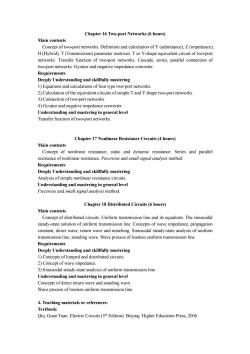
Chapter 16 Two-port Networks(6 hours) Main contents of two-port networks.Definition and calculation of Y(admittance),Z(impedance) H(Hybrid),T(Transmission)parameter matrixes.Tor Y-shape equivalent circuit of two-port networks.Transfer function of two-port networks.Cascade,series,parallel connection of two-port networks.Gyrator and negative impedance converter. Requirements Deeply Understanding and skillfully mastering 1)Equations and caculations of four type two-port networks 2)Calculation of the equivalent circuits of simple T and Y shape two-port networks. 3)Connection of two-port networks. 4)Gyrator and negative impedance converter. Understanding and mastering in general level Transfer function of two-port networks Chapter 17 Nonlinear Resistance Circuits(4 hours) Main contents Concept of nonlinear resistance,static and dynamic resistance.Series and parallel resistance of resistance.Piecewise and small signal metho Requirements Deeply Understanding and skillfully mastering Analysis of simple nonlinear resistance circuits. Understanding Chapter 18 Distributed Circuits(6 hours) Main contents Concept of distributed circuits.Uniform transmission line and its equations.The sinusoidal constant,direct wave,retumn wave and matching Sinusoidal steady-state analysis of uniform transmission line,standing wave.Wave process of lossless uniform transmission line. Requirements Deeply Understanding and skillfully mastering C 2)Concept of wave impedanc 3)Sinusoidal steady-state analysis of uniform transmission line. Understanding and mastering in general level Concepts of direct return wave and standing wave. Wave process of lossless uniform transmission line 4.Teaching materials or references: Textbook: Qiu,Guan Yuan.Electric Circuits(5h Edition).Beijing Higher Education Press,2006
Chapter 16 Two-port Networks (6 hours) Main contents Concept of two-port networks. Definition and calculation of Y (admittance), Z (impedance), H (Hybrid), T (Transmission) parameter matrixes. T or Y-shape equivalent circuit of two-port networks. Transfer function of two-port networks. Cascade, series, parallel connection of two-port networks. Gyrator and negative impedance converter. Requirements Deeply Understanding and skillfully mastering 1) Equations and calculations of four type two-port networks. 2) Calculation of the equivalent circuits of simple T and Y shape two-port networks. 3) Connection of two-port networks. 4) Gyrator and negative impedance converter. Understanding and mastering in general level Transfer function of two-port networks. Chapter 17 Nonlinear Resistance Circuits (4 hours) Main contents Concept of nonlinear resistance, static and dynamic resistance. Series and parallel resistance of nonlinear resistance. Piecewise and small signal analysis method Requirements Deeply Understanding and skillfully mastering Analysis of simple nonlinear resistance circuits. Understanding and mastering in general level Piecewise and small signal analysis method. Chapter 18 Distributed Circuits (6 hours) Main contents Concept of distributed circuits. Uniform transmission line and its equations. The sinusoidal steady-state solution of uniform transmission line. Concepts of wave impedance, propagation constant, direct wave, return wave and matching. Sinusoidal steady-state analysis of uniform transmission line, standing wave. Wave process of lossless uniform transmission line. Requirements Deeply Understanding and skillfully mastering 1) Concepts of lumped and distributed circuits. 2) Concept of wave impedance. 3) Sinusoidal steady-state analysis of uniform transmission line. Understanding and mastering in general level Concepts of direct return wave and standing wave. Wave process of lossless uniform transmission line. 4. Teaching materials or references: Textbook: Qiu, Guan Yuan. Electric Circuits (5 th Edition). Beijing: Higher Education Press, 2006
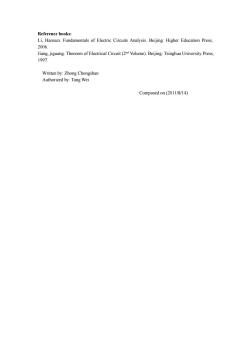
Reference books: Li.Hanxun.Fundamentals of Electric Circuits Analysis.Beijing:Higher Education Press 2006 Jiang,jiguang.Theorem of Electrical Circuit(2 Volume).Beijing:Tsinghua University Press, 1997. Written by:Zhong Chongshan Authorized by:Tang We Composed on(2011/8/14)
Reference books: Li, Hanxun. Fundamentals of Electric Circuits Analysis. Beijing: Higher Education Press, 2006. Jiang, jiguang. Theorem of Electrical Circuit (2 nd Volume). Beijing: Tsinghua University Press, 1997. Written by: Zhong Chongshan Authorized by: Tang Wei Composed on (2011/8/14)
按次数下载不扣除下载券;
注册用户24小时内重复下载只扣除一次;
顺序:VIP每日次数-->可用次数-->下载券;
- 《电路》课程教学大纲 Electric Circuit A.doc
- 《单片机原理与应用》课程教学课件(PPT讲稿)第3章 8051指令系统与编程基础.ppt
- 《单片机原理与应用》课程教学课件(PPT讲稿)第2章 AT89S51单片机硬件结构(1/2).ppt
- 《单片机原理与应用》课程教学课件(PPT讲稿)第2章 AT89S51单片机硬件结构(2/2).ppt
- 《单片机原理与应用》课程教学课件(PPT讲稿)第4章 AT89S52单片机的中断系统(1/2).ppt
- 《单片机原理与应用》课程教学课件(PPT讲稿)第5章 AT89S52单片机的定时器计数器(1/2).ppt
- 《单片机原理与应用》课程教学课件(PPT讲稿)第4章 AT89S52单片机的中断系统(2/2).ppt
- 《单片机原理与应用》课程教学课件(PPT讲稿)第5章 AT89S52单片机的定时器计数器(2/2).ppt
- 《单片机原理与应用》课程教学课件(PPT讲稿)第6章 AT89S52单片机的串行口(1/2).ppt
- 《单片机原理与应用》课程教学课件(PPT讲稿)第6章 AT89S52单片机的串行口(2/2).ppt
- 《单片机原理与应用》课程教学课件(PPT讲稿)ADDA电机(AT89S51单片机与DAC的接口).pptx
- 《单片机原理与应用》课程教学课件(PPT讲稿)DS18B20总线扩展技术.pptx
- 《单片机原理与应用》课程教学资源(学习资料)DS18B20测温头文件使用方法.docx
- 《单片机原理与应用》课程教学资源(授课教案)单片机定时/计数器模块.doc
- 《单片机原理与应用》课程教学资源(授课教案)AT89S52单片机的硬件组成、单片机的引脚功能(一).docx
- 《单片机原理与应用》课程教学资源(授课教案)3.7 8051汇编语言程序设计基础、3.8 汇编语言程序设计举例Keilc程序设计.docx
- 《单片机原理与应用》课程教学资源(授课教案)3.4 8051指令系统分类介绍、C语言中相关编程结构.docx
- 《单片机原理与应用》课程教学资源(授课教案)3.1 指令系统概述 3.2 指令格式 3.3 指令寻址方式 3.4 指令分类.docx
- 《单片机原理与应用》课程教学资源(授课教案)AT89S52单片机的硬件组成、单片机的引脚功能(二).docx
- 《单片机原理与应用》课程教学资源(授课教案)4.8 中断服务子程序的应用设计 4.9 多外部中断源的设计.docx
- 《电路》课程实验教学大纲 Experiment of Electric Circuit A.doc
- 《电路》课程实验教学大纲 Experiment of Electric Circuit B.doc
- 《电路》课程教学资源(实验指导)实验1 元件伏安特性.doc
- 《电路》课程教学资源(实验指导)实验5 RLC元件阻抗特性及交流等效参数的测定.doc
- 《电路》课程教学资源(实验指导)实验3 直流电路基本定理综合实验.doc
- 《电路》课程教学资源(实验指导)实验2 电源等效变换戴维南定理.doc
- 《电路》课程教学资源(实验指导)实验4 电路过渡过程的研究.doc
- 《电路》课程教学资源(实验指导)实验7 RLC串联谐振电路的研究.doc
- 《电路》课程教学资源(实验指导)实验6 日光灯电路及功率因数的提高.doc
- 《电路》课程教学资源(实验指导)实验8 RC选频网络特性的测试.doc
- 《电路》课程教学资源(实验指导)实验9 单相电度表的校验.doc
- 《电路》课程教学资源(实验指导)实验11 三相电路综合实验.doc
- 《电路》课程教学资源(实验指导)实验13 电阻温度计的制作.doc
- 《电路》课程教学资源(实验指导)实验12 二端口网络参数的测定.doc
- 《电路》课程教学资源(实验指导)实验14 运算放大器的应用.doc
- 《电路》课程教学资源(实验指导)实验10 互感与变压器.doc
- 《电路》课程教学资源(实验指导)实验15 移相器的设计与测试.doc
- 《电路》课程教学资源(实验指导)实验16 负阻抗变换器的制作和应用.doc
- 《电路》课程教学资源(实验指导)实验17 RC一阶电路动态特性的仿真.doc
- 《电路》课程教学资源(实验指导)实验18 RLC串联谐振电路的仿真.doc
